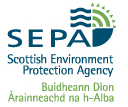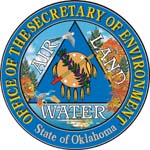
Environmental law is a collective term encompassing aspects of the law that provide protection to the environment. A related but distinct set of regulatory regimes, now strongly influenced by environmental legal principles, focus on the management of specific natural resources, such as forests, minerals, or fisheries. Other areas, such as environmental impact assessment, may not fit neatly into either category, but are nonetheless important components of environmental law.

Environmental science is an interdisciplinary academic field that integrates physical, biological and information sciences to the study of the environment, and the solution of environmental problems. Environmental science emerged from the fields of natural history and medicine during the Enlightenment. Today it provides an integrated, quantitative, and interdisciplinary approach to the study of environmental systems.
Industrial waste is the waste produced by industrial activity which includes any material that is rendered useless during a manufacturing process such as that of factories, industries, mills, and mining operations. Types of industrial waste include dirt and gravel, masonry and concrete, scrap metal, oil, solvents, chemicals, scrap lumber, even vegetable matter from restaurants. Industrial waste may be solid, liquid or gaseous. It may be hazardous or non-hazardous waste. Hazardous waste may be toxic, ignitable, corrosive, reactive, or radioactive. Industrial waste may pollute the air, the soil, or nearby water sources, eventually ending up in the sea. Industrial waste is often mixed into municipal waste, making accurate assessments difficult. An estimate for the US goes as high as 7.6 billion tons of industrial waste produced every year. Most countries have enacted legislation to deal with the problem of industrial waste, but strictness and compliance regimes vary. Enforcement is always an issue.
Environment and Climate Change Canada is the department of the Government of Canada created under the Department of the Environment Act with responsibility for coordinating environmental policies and programs as well as preserving and enhancing the natural environment and renewable resources. The powers, duties and functions of the Minister of the Environment and Climate Change extend to and include matters relating to: "preserve and enhance the quality of the natural environment, including water, air, soil, flora and fauna; conserve Canada's renewable resources; conserve and protect Canada's water resources; forecast daily weather conditions and warnings, and provide detailed meteorological information to all of Canada; enforce rules relating to boundary waters; and coordinate environmental policies and programs for the federal government."

David A. Anderson, is a former Canadian cabinet minister.
The Radiological Protection Institute of Ireland (RPII), An Institiúid Éireannach um Chosaint Raideolaíoch, was an independent public body in Ireland under the aegis of the Department of Communications, Climate Action and Environment. The RPII was established in 1992 under the Radiological Protection Act 1991, which conferred on the RPII a broad remit in relation to radiological protection in Ireland. The RPII was merged with the Environmental Protection Agency (EPA) in August 2014, as part of the Irish Government's Public Sector Reform Plan. RPII's functions are now carried out by the Office of Radiation Protection and Environmental Monitoring within the EPA.

Environmental assessment (EA) is the assessment of the environmental consequences of a plan, policy, program, or actual projects prior to the decision to move forward with the proposed action. In this context, the term "environmental impact assessment" (EIA) is usually used when applied to actual projects by individuals or companies and the term "strategic environmental assessment" (SEA) applies to policies, plans and programmes most often proposed by organs of state. It is a tool of environmental management forming a part of project approval and decision-making. Environmental assessments may be governed by rules of administrative procedure regarding public participation and documentation of decision making, and may be subject to judicial review.

The Scottish Environment Protection Agency is Scotland’s environmental regulator and national flood forecasting, flood warning and strategic flood risk management authority. Its main role is to protect and improve Scotland's environment. SEPA does this by helping business and industry to understand their environmental responsibilities, enabling customers to comply with legislation and good practice and to realise the economic benefits of good environmental practice. One of the ways SEPA does this is through the NetRegs environmental guidance service. It protects communities by regulating activities that can cause harmful pollution and by monitoring the quality of Scotland's air, land and water. The regulations it implements also cover the storage, transport and disposal of radioactive materials.
Environmental law in New Zealand is an increasingly well defined body of national law that has a specialist court, The Environment Court of New Zealand, to decide related issues.
Environmental planning is the process of facilitating decision making to carry out land development with the consideration given to the natural environment, social, political, economic and governance factors and provides a holistic framework to achieve sustainable outcomes. A major goal of environmental planning is to create sustainable communities, which aim to conserve and protect undeveloped land.

The North Carolina Department of Environmental Quality (NCDEQ) is North Carolina's leading stewardship agency for the preservation and protection of natural resources and public health. The Department is headed by the Secretary of Environmental Quality, who is appointed by the Governor of North Carolina and is a member of the North Carolina Cabinet. The Department of Environmental Quality was formed in 2015 and it was proceeded by the Department of Environmental and Natural Resources, which was formed in 1971 by the North Carolina Executive Reorganization Act.

The Environmental Protection Administration, Executive Yuan is a cabinet-level executive agency responsible for protecting and conserving the environment in the Republic of China. This also includes, air quality, noise control, monitoring and inspection of environment, solid waste, recycling, sustainable development and international cooperation.

The environment of Malaysia refers to the biotas and geologies that constitute the natural environment of this Southeast Asian nation. Malaysia's ecology is megadiverse, with a biodiverse range of flora and fauna found in various ecoregions throughout the country. Tropical rainforests encompass between 59% to 70% of Malaysia's total land area, of which 11.6% is pristine. Malaysia has the world's fifth largest mangrove area, which totals over a half a million hectares.

The Oklahoma Secretary of Environment is a member of the Oklahoma Governor's Cabinet. The Secretary is appointed by the Governor, with the consent of the Oklahoma Senate, to serve at the pleasure of the Governor. The Secretary serves as the chief advisor to the Governor on environmental policy development and implementation.

The province of New Brunswick has created and implemented various Acts, such as the Clean Environment Act, Clean Air Act, and the Clean Water Act, throughout history to ensure that the environment is considered and protected throughout various project. These acts describe the process that will be undertaken to assess the impact of projects, and the steps to be taken when certain situations arise.
This is a list of notable events relating to the environment in 1991. They relate to environmental law, conservation, environmentalism and environmental issues.

Environment Protection Act, 1986 is an Act of the Parliament of India. In the wake of the Bhopal Tragedy, the Government of India enacted the Environment Protection Act of 1986 under Article 253 of the Constitution. Passed in March 1986, it came into force on 19 November 1986. It has 26 sections and 4 chapters. The purpose of the Act is to implement the decisions of the United Nations Conference on the Human Environment. They relate to the protection and improvement of the human environment and the prevention of hazards to human beings, other living creatures, plants and property. The Act is an “umbrella” legislation designed to provide a framework for central government coordination of the activities of various central and state authorities established under previous laws, such as the Water Act and the Air Act.

The Telangana Pollution Control Board is a body of the Department of Health and Family Welfare, Government of the State of Telangana, India. The board is charged with enforcing laws related to environmental protection.
The Department of the Environment and Energy (DEE) was an Australian government department in existence between 2016 and 2020.